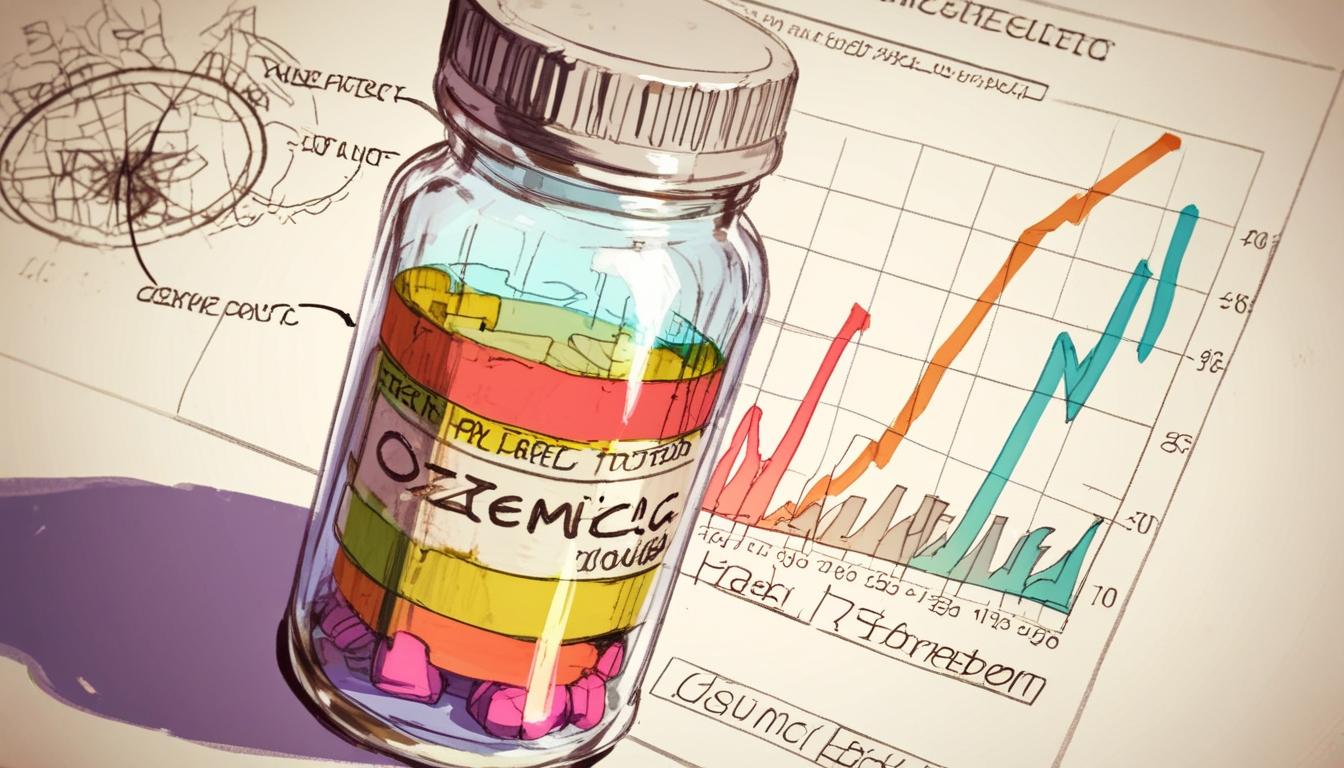Adverse reaction reports linked to popular weight-loss medications like Ozempic and Wegovy could climb dramatically in the coming year, raising fresh concerns about serious health risks and prompting calls for careful medical supervision.
New data indicating a dramatic rise in reports of adverse reactions related to popular weight-loss drugs, such as Ozempic and Wegovy, has raised alarms among healthcare professionals and patients alike. Prognostic estimates suggest that severe side effects could increase by over 350% within just one year, potentially leading to 7,200 reported reactions in 2024, a staggering rise from 1,592 in 2023. Current figures collected from January to May last year have already recorded 2,780 reactions, with health officials cautioning that not all reported incidents are confirmed as drug-related.
These drugs, particularly those containing the ingredient semaglutide, operate by mimicking the hormone GLP-1, which signals the brain when to feel full, thus curbing appetite and aiding in weight loss. While they have gained popularity for managing obesity and type-2 diabetes, the concerns over serious side effects cannot be overlooked. Reports of digestive issues such as stomach paralysis and bowel obstructions sit alongside more common complaints, including nausea and extreme bloating. Furthermore, the Medicines and Healthcare products Regulatory Agency (MHRA) has noted that while serious side effects are a concern, the adverse reactions reported by doctors and patients are not independently verified and may not definitively indicate a causal relationship with the medication.
In the United States, over 200 deaths have been associated with Ozempic and similar medications; however, establishing a direct link remains contentious. In the UK, there have been 82 reported fatalities connected to these drugs, though causation has yet to be confirmed.
Patient experiences underscore the potential risks. Karen Coe, a 59-year-old who began taking Mounjaro, a similar medication, shared her harrowing experience after just three days on the drug. Initially suffering from dizziness and severe abdominal cramps, Coe found herself in excruciating pain that culminated in a hospital visit for blood clots. The seriousness of her condition prompted consultations with specialists, although doctors could not definitively link her health issues to the medication. “It felt like being ripped open by a knife,” she reflected, emphasising her belief that prospective users should consider these risks seriously before commencing treatment.
Assessments from the MHRA have not identified a direct correlation between GLP-1 receptor agonists and mental health issues such as suicidal thoughts, affirming the need for ongoing monitoring of new data as it emerges. These findings were based on extensive reviews of post-marketing data and clinical studies. Moreover, efforts are made to inform healthcare professionals about the potential misuse of these medications and their side effects, underlining that these treatments should only be taken under medical supervision.
Healthcare responses to the surge in side effects have included the issuing of safety reminders by government authorities, prompting a broader discussion on the ethical prescribing of weight-loss medications. The government has echoed the necessity for both patients and doctors to remain vigilant about potential side effects, emphasising that drugs like Ozempic and Mounjaro should not be treated lightly, as they can lead to serious gastrointestinal problems and, in severe instances, kidney damage.
In light of these developments, Eli Lilly, the manufacturer of Mounjaro, has expressed its commitment to patient safety. The company stated it takes all reports concerning patient safety seriously and advises individuals to consult healthcare providers regarding any adverse symptoms.
As the figures surrounding adverse reactions continue to grow, the call for caution echoes louder, beckoning both patients and healthcare providers to reevaluate their approach to these increasingly prescribed medications. With ongoing monitoring essential, the landscape of obesity management may necessitate a more nuanced understanding of the risks and benefits associated with popular weight-loss drugs.
Reference Map
- Paragraphs 1, 2, 3, 4, 5, 6, 7
- Paragraphs 6, 7
- Paragraphs 6, 7
- Paragraph 4
- Paragraphs 3, 6
- Paragraph 3
- Paragraphs 3, 6
Source: Noah Wire Services
- https://www.dailymail.co.uk/health/article-14695421/Alarm-severe-reactions-Ozempic-set-SOAR-350-cent-new-data-reveals.html?ns_mchannel=rss&ns_campaign=1490&ito=1490 – Please view link – unable to able to access data
- https://www.gov.uk/government/news/mhra-finds-evidence-does-not-support-a-link-between-glucagon-like-peptide-1-glp-1-receptor-agonists-and-suicidal-and-self-injurious-thoughts-and-act – The UK’s Medicines and Healthcare products Regulatory Agency (MHRA) conducted a thorough review and concluded that there is no causal relationship between GLP-1 receptor agonists, such as Ozempic, and suicidal behavior, suicidal ideation, self-injury, or depression. This assessment was based on post-marketing data, clinical trials, epidemiological studies, and scientific literature. The MHRA emphasized the importance of continuous monitoring and will assess new data as it becomes available.
- https://www.gov.uk/drug-safety-update/glp-1-receptor-agonists-reminder-of-the-potential-side-effects-and-to-be-aware-of-the-potential-for-misuse – The UK government issued a safety update regarding GLP-1 receptor agonists, highlighting potential side effects such as nausea, vomiting, diarrhea, and constipation, which can lead to dehydration and, in severe cases, kidney damage. The update also addressed the misuse of these medications for weight loss, emphasizing that they are prescription-only and should be used under medical supervision. Healthcare professionals are advised to inform patients about these risks and the importance of proper usage.
- https://www.ozempic.com/how-to-take/side-effects.html – The official Ozempic website provides detailed information on potential side effects associated with the medication. Serious side effects include possible thyroid tumors, inflammation of the pancreas (pancreatitis), changes in vision, low blood sugar (hypoglycemia), kidney problems, severe stomach issues, serious allergic reactions, and gallbladder problems. The site advises patients to consult their healthcare provider if they experience any of these symptoms and to read the patient information leaflet for comprehensive details.
- https://www.novomedlink.com/diabetes/products/treatments/ozempic/efficacy-safety/safety-profile.html – Novo Nordisk’s official page on Ozempic’s safety profile outlines various adverse reactions observed in clinical trials. Common side effects include nausea, vomiting, diarrhea, abdominal pain, and constipation. The page also highlights serious risks such as thyroid C-cell tumors, acute pancreatitis, diabetic retinopathy complications, severe gastrointestinal issues, hypersensitivity reactions, acute gallbladder disease, and potential pulmonary aspiration during anesthesia. Patients are encouraged to discuss these risks with their healthcare provider before starting treatment.
- https://www.drugwatch.com/drugs/ozempic/side-effects/ – Drugwatch provides an overview of the side effects associated with Ozempic, including gastrointestinal issues like nausea, vomiting, diarrhea, and abdominal pain. The article also discusses more serious side effects such as thyroid tumors, pancreatitis, and potential vision problems. Additionally, it mentions the FDA’s investigation into reports of hair loss and suicidal thoughts linked to Ozempic, noting that while no direct connection has been established, the agency continues to monitor these reports.
- https://www.rightpatient.com/guest-blog-posts/ozempic-side-effects-understanding-the-risks-and-symptoms/ – RightPatient’s guest blog post delves into the risks and symptoms associated with Ozempic. It highlights potential side effects like kidney injury, allergic reactions, and hypoglycemia. The article emphasizes the importance of monitoring for symptoms such as reduced urine output, swelling, fatigue, and confusion, especially in patients with pre-existing kidney conditions or those who become dehydrated. It also advises patients to seek immediate medical attention if they experience signs of an allergic reaction or low blood sugar.
Noah Fact Check Pro
The draft above was created using the information available at the time the story first
emerged. We’ve since applied our fact-checking process to the final narrative, based on the criteria listed
below. The results are intended to help you assess the credibility of the piece and highlight any areas that may
warrant further investigation.
Freshness check
Score:
8
Notes:
The narrative references recent data from 2023 and 2024, indicating it is up-to-date. However, without information on when these figures were last updated, it misses a perfect score.
Quotes check
Score:
9
Notes:
The quote from Karen Coe appears to be original and specific to this context. There is no evidence of its prior use in other articles.
Source reliability
Score:
7
Notes:
The Daily Mail is a well-known publication, but it has been subject to criticism for sensationalism. The narrative cites data and regulatory agency comments, which adds credibility.
Plausability check
Score:
8
Notes:
The claims about side effects align with known concerns over these medications, although some statements lack concrete evidence of causality.
Overall assessment
Verdict (FAIL, OPEN, PASS): OPEN
Confidence (LOW, MEDIUM, HIGH): MEDIUM
Summary:
While the narrative is recent and includes original quotes, concerns over sensationalism and lack of causal evidence for some claims temper confidence in its overall accuracy.













